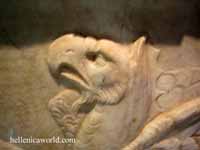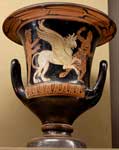.

As you enter the temple that they name the Parthenon, all the sculptures you see on what is called the pediment refer to the birth of Athena, those on the rear pediment represent the contest for the land between Athena and Poseidon. The statue itself is made of ivory and gold. On the middle of her helmet is placed a likeness of the Sphinx — the tale of the Sphinx I will give when I come to my description of Boeotia — and on either side of the helmet are griffins in relief. These griffins, Aristeas of Proconnesus says in his poem, fight for the gold with the Arimaspi beyond the Issedones. The gold which the griffins guard, he says, comes out of the earth; the Arimaspi are men all born with one eye; griffins are beasts like lions, but with the beak and wings of an eagle. I will say no more about the griffins Pausanias
The Griffin (Greek gryphos, Persian شیردال shirdal "lion-eagle") (also spelled gryphon and, less commonly, gryphen, griffon, griffen, or gryphin) is a legendary creature with the body of a lion and the head and wings of an eagle. Often, griffins are depicted with a pair of prominent ears, traditionally termed "ass' ears". Since the lion was considered the "King of the Beasts" and the eagle the "King of the Air", the griffin was thought to be an especially powerful and majestic creature. Some traditions say that only female griffins have wings. The griffin is generally represented with four legs, wings and a beak, with eagle-like talons in place of a lion's forelegs and equine ears jutting from its skull. Some writers describe the tail as a serpent. See the entry European dragon for a 19th century painting of St George and the dragon, showing a dragon very like a classically-conceived griffin.
Classical and heraldic griffins are male and female. A so-called "male" griffin, called a keythong in a single 15th century English heraldic manuscript, is an anomaly that belongs strictly to a late phase of English heraldry: see below.
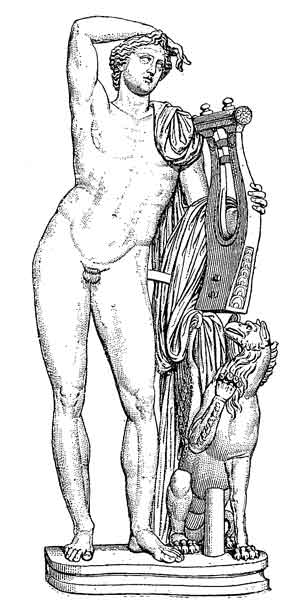
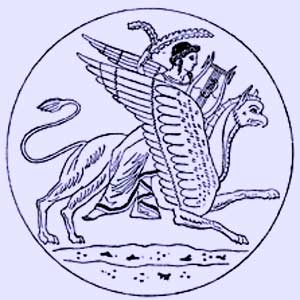
Apollo with a Griffin and on a Griffin
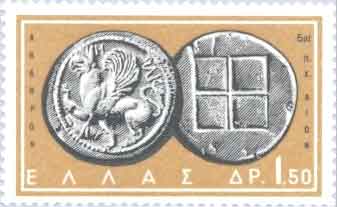
Abdera Coin with the Griffin, 5th century BC

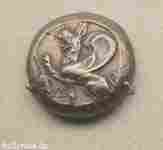
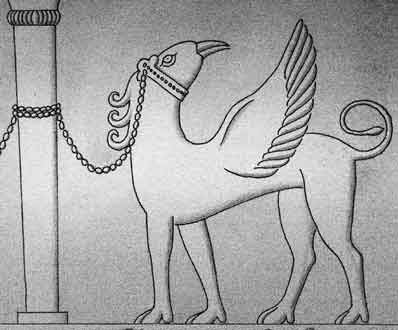
Minoan griffin, Kreta ,Archaeological Museum Crete, August 2004 , Photo: Agon S. Buchholz

Jug, griffin, BM 1873-8-20-385
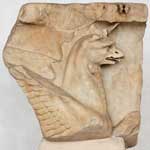
Nature of griffins
Tales of griffins and the Arimaspi of distant Scythia near the cave of Boreas, the North Wind (Geskleithron) were elaborated in the lost archaic poem of Aristeas of Proconnesus, Arimaspea, and eagerly reported by Herodotus and in Pliny's Natural History. The griffin was said to build a nest, like an eagle. Instead of eggs, it lays agates. The animal was supposed to watch over gold mines and hidden treasures, and to be the enemy of the horse. The incredibly rare offspring of griffin and horse would be called hippogriff.
Griffin was consecrated to the Sun; and ancient painters represented the chariot of the Sun as drawn by griffins. The griffin was a common feature of "animal style" Scythian gold; it was said to inhabit the Scythia steppes that reached from the modern Ukraine to central Asia; there gold and precious stones were abundant; and when strangers approached to gather the stones, the creatures would leap on them and tear them to pieces. The Scythians used giant petrified bones found in this area as proof of the existence of griffins and to keep outsiders away from the gold and precious stones. It has recently been suggested that these "griffin bones" were actually dinosaur fossils, which are common in this part of the world.
Adrienne Mayor, a classical folklorist, has made tentative connections, in Fossil Hunters: Paleontology in Greek and Roman Times, between the rich fossil beds around the Mediterranean and across the steppes to the Gobi Desert and the myths of griffins, centaurs and archaic giants originating in the classical world. Mayor draws upon striking similarities that exist between the Protoceratops skulls of the steppes leading to the Gobi Desert, and the legends of the gold-hoarding griffin told by nomadic Scythians of the region; among the artistic evidence, the 6th century Greek vase on the book's cover is incontrovertible. The size of that fossil skull may be the source of the claim that a griffin is eight times the size of a lion.
Ancient Elamites used griffin symbol extensively in their architecture. In Elam legends, a Griffin was presented to a Elamite Gods. In Persian mythology, in particular during the Achaemenid dynasty, griffins called Homa were used widely as statues and symbols in palaces. Homa also had a special place in Persian literature as guardians of light.
A 9th century Irish writer by the name of Stephen Scotus asserted that griffins were highly monogamous. Not only did they mate for life, but if one partner died, the other would continue throughout the rest of its life alone, never to search out for a new mate. The griffin was thus made an emblem of the Church's views on remarriage. Being in part both a flying and a landbound animal, it was seen in Christianity to be a symbol of Jesus (who was both human and divine).
The egg-laying habits of the female were first clearly described by St. Hildegard of Bingen, a German nun author of the 12th century. She outlined how the expectant mother would search out a cave with a very narrow entrance but plenty of room inside, sheltered from the elements. Here she would lay her 3 eggs (about the size of Ostrich eggs), and stand guard over them.
In architectural decoration the griffin is usually represented as a four-footed beast with wings and the head of a leopard or tiger with horns, or with the head and beak of an eagle. The griffin is the symbol of the Philadelphia Museum of Art and you can see bronze castings of them perched on each corner of the museum's roof, protecting its collection.
A griffin (spelled "gryphon") is featured in Lewis Carroll's Alice in Wonderland in which the Queen of Hearts' orders the gryphon to take Alice to see the Mock Turtle and hear its story. The original illustrations by Sir John Tenniel depict the gryphon in an unusually naturalistic style (pictured to the left).
Some large species of Old World vultures are called gryphons, including the griffon vulture (Gyps fulvus), as are some breeds of dog (griffons).
The scientific species name for the Andean Condor is Vultur gryphus; Latin for "griffin-vulture".
Hippogriffs
Griffins are traditionally regarded as having an antipathy for horses. Therefore the hippogriff, being the offspring of a horse and a griffin, was a doubly impossible being. Nevertheless, some tales depicted their existence. For the same reason, the hippogriff is sometimes used as a symbol of love; only consider the power of the love between a griffin and a horse it would take for such a creature to be born.
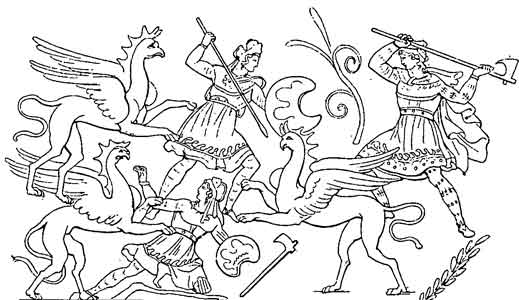
Battle of Arimaspi with the griffins
Heraldic griffins
The griffin is often seen as a charge in heraldry.
A heraldic griffin (or gryphon) has the hind parts (including legs and tail) of a lion, the upper parts (including feathered neck, wings, claws, and head with beak) of an eagle and also ears. It is the ears which distinguish the griffin's head from an eagle's head in heraldry, which is important because, as well as the full griffin, the griffin's head is also often found in heraldry and would otherwise be identical to the head of the eagle.
According to the Tractatus de armis of John de Bado Aureo (late fourteenth century) “A griffin borne in arms signifies that the first to bear it was a strong pugnacious man in whom were found two distinct natures and qualities, those of the eagle and the lion”. This is clearly fanciful, but since the lion and the eagle were both important charges in heraldry, it is perhaps not surprising that their hybrid, the griffin, was also a frequent choice. The symbolism of the lion-eagle combination was also the subject of a quotation attributed to Chassaneus by Alexander Nisbet in his System of Heraldry (1722; p 343 of Vol I of the 1816 edn): "Gryphus significat sapientiam jungendam fortitudini, sed sapientiam debere praeire, fortitudinem sequi.". This translates as: “The griffin represents wisdom joined to fortitude, but wisdom should lead, and fortitude follow".
Heraldic griffins are usually shown rearing up, facing left, and standing on one hind leg with the other leg and the claws raised: this posture is described in the Norman-French language of heraldry as "segreant", a word uniquely applied to griffins, and which is the exact equivalent of the description of lions and other creatures in heraldry as "rampant".
A heraldic griffin was included as one of the ten Queen's Beasts sculpted for the coronation of Queen Elizabeth II in 1953 (following the model of the King’s Beasts at Hampton Court) and this is now on display at Kew Gardens.
The City of London adopted what are usually described as griffins as supporters for its coat of arms, and it marks its boundaries with statues of a single "griffin" carrying the City coat of arms at each road leading into the City of London. However, the City of London griffins are, in fact, heraldic dragons, with scaly bodies and wings, no feathers, and no eagle's beak.
The "keythong"
The heraldic beast called a "keythong" much enjoyed among members of the Society for Creative Anachronism is claimed to appear in a single English manuscript of the reign of Edward IV, a heraldic solipsism. J.R. Planche's Pursuivant of Arms (London 1859) notes, under the badge of the Earl of Ormonde (first creation) as recorded in a College of Arms manuscript under Edward IV, the single contemporary reference: "A pair of keythongs." Planche's footnote: "The word is certainly so written, and I have never seen it elsewhere. The figure resembles the Male Griffin, which has no wings, but rays or spikes of gold proceeding from several parts of his body, and sometimes with two long straight horns. Vade Parker's Glossary, under Griffin." (Society of Creative Anachronism website). At the end of the 20th century the "keythong" began to be taken up enthusiastically among amateurs of heraldry
Griffins in literature
A griffin ghost-writes myth and legend novels and reads stories to children at a local library in Collinsfort Village by Joe Ekaitis.
Alice in Wonderland by Lewis Carroll (see reference in summary above)
The Crossroads series by Nick O'Donohoe, including The Magic and the Healing, Under the Healing Sign, and Healing of Crossroads. Griffins play a significant role in this series about veterinary students called upon to help mythological creatures.
Three varieties of griffins, with different spellings and very different dispositions, appear in the popular children's novel David and the Phoenix by Edward Ormondroyd.
Griffins are among the magical creatures that exist in the Harry Potter series. Harry Potter's house (i.e., grouping of pupils) at Hogwarts School of Witchcraft and Wizardry is called Gryffindor, after its founder Godric Gryffindor. "Gryffindor" may come from the French "gryffon d'or" or "golden griffin", but, oddly, its emblem is a lion and not a griffin.
The Griffin and the Minor Canon by Frank R Stockton, illustrated by Maurice Sendak (1968)
Gryphons are among the creatures in Aslan's army in The Chronicles of Narnia.
The Mage Wars Trilogy by Mercedes Lackey and Larry Dixon. A gryphon known as Skandranon is one of the lead characters. Titles are The Black Gryphon, The White Gryphon and The Silver Gryphon.
The Divine Comedy by Dante Alighieri. A griffin pulls the chariot which brings Beatrice to Dante in Canto XXIX of the Purgatory.
Revenge of the Shadow King by Derek Benz and J.S. Lewis
A human baby turns into a griffin in Wilanne Schneider Belden's Frankie!
Griffins play a part in the Dragonlance novels, under the command of Elves.
In the Eberron campaign setting for Dungeons & Dragons, the griffon is the heraldic animal of the dragonmarked House Jorasco.
In The Once and Future King by T. H. White, young Arthur and his step-brother Kay battle a fierce griffin with aid from Robin Hood soon after freeing captives of Morgan le Fay.
Spelling variants
Griffin has been spelled various ways: gryphon, griffen, griffon, griffoun, griffun, griffyn, grifo, grifon, grifyn, grefyne, gríobhán, griphin, griphon, gryffen, gryffin, gryffon, gryfon, gryf, gryphen, and gryphin.
Apollo riding a griffin while playing the lyre
The Gryphon Pages, a comprehensive collection of all things pertaining to gryphons, from history and literature, to heraldry, to art both ancient and new.
Griffins in Art and on the Web, an "art history through griffins"
Greek Mythology Link Bestiary: Griffin, quoting Herodotus, Pausanias, Strabo
Fossil Hunters: Paleontology in Greek and Roman Times
Lady Gryphon's Mythical Realm: Griffin Aerie
See also : Greek Mythology. Paintings, Drawings
| Ancient Greece
Science, Technology , Medicine , Warfare, , Biographies , Life , Cities/Places/Maps , Arts , Literature , Philosophy ,Olympics, Mythology , History , Images Medieval Greece / Byzantine Empire Science, Technology, Arts, , Warfare , Literature, Biographies, Icons, History Modern Greece Cities, Islands, Regions, Fauna/Flora ,Biographies , History , Warfare, Science/Technology, Literature, Music , Arts , Film/Actors , Sport , Fashion --- |
Retrieved from "http://en.wikipedia.org"
All text is available under the terms of the GNU Free Documentation License


